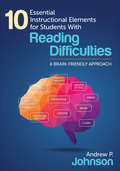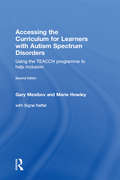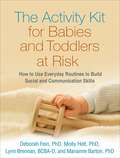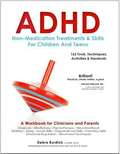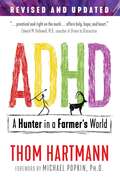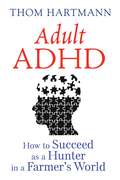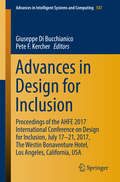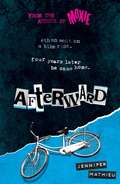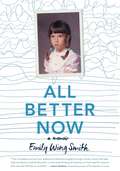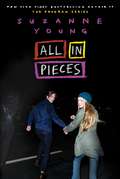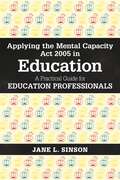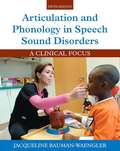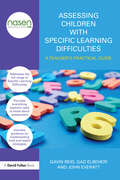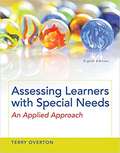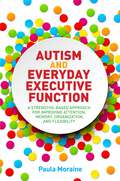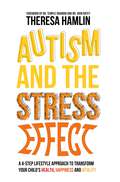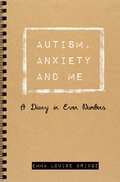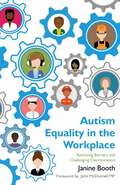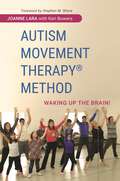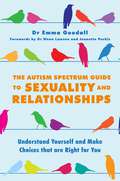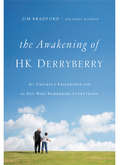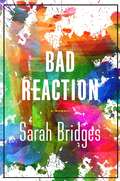- Table View
- List View
10 Essential Instructional Elements for Students With Reading Difficulties: A Brain-Friendly Approach
by Andrew P. JohnsonBrain-friendly strategies to help all students become lifelong readers Learning to read is more than just an educational issue; it’s a social justice issue. Did you know that struggling readers are twice as likely as their peers to drop out of high school? Through time-tested, research-based neurocognitive teaching strategies, 10 Essential Instructional Elements for Students with Reading Difficulties will enable you to hone readers’ skills and help students from all grade levels develop their ability to create meaning from print. Drawing from five key areas of neurocognitive research, Andrew Johnson provides a ten-point teaching strategy that encompasses vocabulary, fluency, comprehension, writing and more. A key resource for creating intervention plans for struggling readers, features include: Information on the often-overlooked importance of emotions in the process of overcoming reading struggles Strategies to promote voluntary reading, even for the most reluctant students Useful resources such as graphic organizers, additional reading and writing activities, and QR codes that link to videos Use these strategies today and you can count on more students leaving your classrooms as fluent, lifelong readers. "Dr. Johnson tells the story of reading in a logical and clear manner with a book that is excellently researched, immaculately referenced, and full of practical tips for the practitioner." Terry Bernstein, Former Senior Literacy Difficulties Specialist London Boroughs of Camden and Westminster, UK "This is the text I wish I had when I began to teach. Dr. Johnson clearly illustrates the process our brain uses to create meaning from text." Marty Duncan, Ed.D., Author and Former Educator
10 Essential Instructional Elements for Students With Reading Difficulties: A Brain-Friendly Approach
by Andrew P. JohnsonBrain-friendly strategies to help all students become lifelong readers Learning to read is more than just an educational issue; it’s a social justice issue. Did you know that struggling readers are twice as likely as their peers to drop out of high school? Through time-tested, research-based neurocognitive teaching strategies, 10 Essential Instructional Elements for Students with Reading Difficulties will enable you to hone readers’ skills and help students from all grade levels develop their ability to create meaning from print. Drawing from five key areas of neurocognitive research, Andrew Johnson provides a ten-point teaching strategy that encompasses vocabulary, fluency, comprehension, writing and more. A key resource for creating intervention plans for struggling readers, features include: Information on the often-overlooked importance of emotions in the process of overcoming reading struggles Strategies to promote voluntary reading, even for the most reluctant students Useful resources such as graphic organizers, additional reading and writing activities, and QR codes that link to videos Use these strategies today and you can count on more students leaving your classrooms as fluent, lifelong readers. "Dr. Johnson tells the story of reading in a logical and clear manner with a book that is excellently researched, immaculately referenced, and full of practical tips for the practitioner." Terry Bernstein, Former Senior Literacy Difficulties Specialist London Boroughs of Camden and Westminster, UK "This is the text I wish I had when I began to teach. Dr. Johnson clearly illustrates the process our brain uses to create meaning from text." Marty Duncan, Ed.D., Author and Former Educator
Accessing the Curriculum for Learners with Autism Spectrum Disorders: Using the TEACCH programme to help inclusion
by Gary Mesibov Marie Howley Signe NaftelThis brand new edition of Accessing the Curriculum for Learners with Autistic Spectrum Disorders will provide educators with the principles and practices of Structured Teaching and how to apply these to enable learners to access the curriculum, whatever that curriculum may be. This unique resource is intended to be essential reading for schools and settings who are keen to implement Structured Teaching as an approach to including learners on the autism spectrum in teaching and learning. With a wide range of helpful advice and support, this book: demonstrates how to make use of the approach to address diverse needs, overcome barriers to learning and achieve successful differentiation; uses case studies and examples that illustrate how the approach is applicable across Early years, Primary, Secondary and vocational curricula; provides the physical structure, schedules, work systems and visual information necessary to illustrate use of these components to promote curriculum access, with an emphasis on understanding and meaning. This new edition is fully updated to include examples of new technologies and is suitable for use in a range of international educational contexts. It also includes a brand new chapter on blending Structured Teaching.
The Activity Kit for Babies and Toddlers at Risk
by Molly Helt Deborah Fein Lynn Brennan Marianne BartonSuspecting that your baby or toddler may have autism spectrum disorder or another developmental delay can be scary and overwhelming. But there is a lot you can do to help, even while waiting for an evaluation or early intervention. With the right tools, everyday tasks can be terrific opportunities for building critical social and communication skills. Start at the kitchen table, bathtub, or shopping cart! In this easy-to-navigate guide, leading experts present more than 100 games and activities designed to support development in children from birth to age 3. Your child's daily routines are transformed into learning opportunities that promote crucial abilities, like how to imitate others or use simple hand gestures to convey wants and needs. As a parent, you are the most important person in your child's life. Now you can be the best teacher, too.
ADHD: A Hunter in a Farmer’s World
by Thom HartmannA newly revised and updated edition of the classic guide to reframing our view of ADHD and embracing its benefits • Explains that people with ADHD are not disordered or dysfunctional, but simply “hunters in a farmer’s world”--possessing a unique mental skill set that would have allowed them to thrive in a hunter-gatherer society • Offers concrete non-drug methods and practices to help hunters--and their parents, teachers, and managers--embrace their differences, nurture creativity, and find success in school, at work, and at home • Reveals how some of the world’s most successful people can be labeled as ADHD hunters, including Benjamin Franklin, Thomas Edison, and Andrew Carnegie With 10 percent of the Western world’s children suspected of having Attention Deficit Disorder, or ADHD, and a growing number of adults self-diagnosing after decades of struggle, the question must be raised: How could Nature make such a “mistake”? In this updated edition of his groundbreaking classic, Thom Hartmann explains that people with ADHD are not abnormal, disordered, or dysfunctional, but simply “hunters in a farmer’s world.” Often highly creative and single-minded in pursuit of a self-chosen goal, those with ADHD symptoms possess a unique mental skill set that would have allowed them to thrive in a hunter-gatherer society. As hunters, they would have been constantly scanning their environment, looking for food or threats (distractibility); they’d have to act without hesitation (impulsivity); and they’d have to love the high-stimulation and risk-filled environment of the hunting field. With our structured public schools, office workplaces, and factories those who inherit a surplus of “hunter skills” are often left frustrated in a world that doesn’t understand or support them. As Hartmann shows, by reframing our view of ADHD, we can begin to see it not as a disorder, but as simply a difference and, in some ways, an advantage. He reveals how some of the world’s most successful people can be labeled as ADHD hunters and offers concrete non-drug methods and practices to help hunters--and their parents, teachers, and managers--embrace their differences, nurture creativity, and find success in school, at work, and at home. Providing a supportive “survival” guide to help fine tune your natural skill set, rather than suppress it, Hartmann shows that each mind--whether hunter, farmer, or somewhere in between--has value and great potential waiting to be tapped.
Adult ADHD: How to Succeed as a Hunter in a Farmer’s World
by Thom HartmannHow to harness your ADHD “hunter” strengths to start your own business and prosper in the workplace• Provides organizational strategies, tips to maintain focus, and tools to set goals, build a business plan, and discover the right project to keep you motivated• Shares ADHD success stories from Fortune 500 CEOs, inventors, small business owners, and the author’s own experience in launching new businesses• Explains the positive side of ADHD behavior in the context of creating a business, working within an existing company, and raising children with ADHDMost people do not “grow out” of Attention Deficit Disorder (ADD) or Attention Deficit Hyperactivity Disorder (ADHD). For many, their ADHD traits have led to difficulties in school, relationships, and work. But for our hunter-gatherer ancestors these characteristics were necessary for survival. Hunters must be easily distractible, constantly scanning their environment, and unafraid of taking risks. When humanity experienced the agricultural revolution 10,000 years ago, a vastly different type of personality--the methodical “Farmer”--became dominant. Most of our modern world is tailored to this Farmer personality, from 9-to-5 jobs to the structure of public schools, leaving ADHD Hunters feeling like unsuccessful outcasts. However, the Hunter skill set offers many opportunities for success in today’s Farmer society--if you learn how to embrace your ADHD traits instead of fighting against them.In this step-by-step guide, Thom Hartmann explains the positive side of Hunter behavior. He reveals how Hunters make excellent entrepreneurs, sharing ADHD success stories from Fortune 500 CEOs, inventors, small business owners, and his own hands-on experience in launching new businesses. Drawing on solid scientific and psychological principles, he provides easy-to-follow organizational strategies, tips to maintain focus and create a distraction-free workspace, and tools to set goals, build a business plan, and discover the right business project to keep you motivated. Hartmann shares valuable advice for both the Hunter entrepreneur and the Hunter within an existing company and for curtailing the aggressive side of the Hunter personality in group situations or manager positions. Revealing the many ADHD opportunities hidden within the challenges of work, relationships, and day-to-day life, Hartmann also includes tips on navigating family relationships and parenting--for most Hunter parents are also raising Hunter children.
Adult Continuing Education and High School Course Catalog
by Hadley Institute for the Blind Visually ImpairedAdult Continuing Education and High School Course Catalog 2016-2017. Catalog of current distance education courses for the blind or visually impaired. Various media for the courses is available including; Braille, CD, Digital Talking Books, Large Print, Online and more. Not all courses are available in all formats.
Advances in Design for Inclusion: Proceedings of the AHFE 2017 International Conference on Design for Inclusion, July 17–21, 2017, The Westin Bonaventure Hotel, Los Angeles, California, USA (Advances in Intelligent Systems and Computing #587)
by Giuseppe Di Bucchianico Pete F KercherThis book focuses on a range of topics in design, such as universal design, design for all, digital inclusion, universal usability, and accessibility of technologies independently of people s age, economic situation, education, geographic location, culture and language. It especially focuses on accessibility for people with auditory, cognitive, neurological, and visual impairments, ageing populations, and mobility for physical special needs. The book explores some of the overlaps between inclusive design and web accessibility to help managers, designers, developers, policy makers, and researchers optimize their efforts in these overlapping areas. Based on the AHFE 2016 International Conference on Design for Inclusion, held on July 27-31, 2016, in Walt Disney World(r), Florida, USA, this book discusses new design technologies, highlighting various requirements of individuals within a community. Thanks to its multidisciplinary approach, the book represents a useful resource for readers with different kinds of backgrounds and provides them with a timely, practice-oriented guide to design for inclusion. "
Afterward
by Jennifer MathieuFrom the author of Moxie, soon to be a major Netflix production, directed by Amy Poehler.From the author of MOXIE, comes a moving story of self-discovery and the hope that comes with friendship.Ethan Jorgensen went on a bike ride four years ago, and has not been seen since ...When Caroline's little brother is kidnapped, his subsequent rescue leads to the discovery of Ethan, now fifteen years old. Caroline can't help but wonder what happened to her brother who has non-verbal autism and is not adjusting well to life back home. And there's only one person who knows the truth: Ethan.But Ethan isn't sure how he can help Caroline when he is fighting traumatic memories of his own time in captivity.One thing's for sure. Both Caroline and Ethan need a friend, and their best option just might be each other ...
All Better Now
by Emily Wing SmithI ask myself: how am I living still? And how I ask it depends on the day. All her life, Emily has felt different from other kids. Between therapist visits, sudden uncontrollable bursts of anger, and unexplained episodes of dizziness and loss of coordination, things have always felt not right. For years, her only escape was through the stories she'd craft about herself and the world around her. But it isn't until a near-fatal accident when she's twelve years old that Emily and her family discover the truth: a grapefruit sized benign brain tumor at the base of her skull. In turns candid, angry, and beautiful, Emily Wing Smith's captivating memoir chronicles her struggles with both mental and physical disabilities during her childhood, the devastating accident that may have saved her life, and the means by which she coped with it all: writing.
All in Pieces
by Suzanne YoungFrom <i>New York Times</i> bestselling author Suzanne Young comes a heartrending new novel about a girl struggling to deal with anger issues while taking care of her younger brother with special needs. <p>"Anger-management issues." That's how they classified Savannah Sutton after she stuck a pencil in her ex-boyfriend's hand because he mocked her little brother, Evan, for being disabled. That's why they sent her to Brooks Academy--an alternative high school that's used as a temporary detention center. <p>The days at Brooks are miserable, but at home, life is far more bleak. Savvy's struggling to take care of her brother since her mom left years ago, and her alcoholic dad can't be bothered. Life with Evan is a constant challenge, but he's also the most important person in the world to Savvy. <p>Then there's Cameron, a new student at Brooks with issues of his own; a guy from a perfect family that Savvy thought only existed on TV. Cameron seems determined to break through every one of the walls Savvy's built around herself, except if she lets herself trust him, it could make everything she's worked so hard for fall apart in an instant. <p>And with her aunt seeking custody of her brother and her ex-boyfriend seeking revenge, Savvy's fighting to hold all the pieces together. But she's not sure how much tighter she can be pulled before she breaks completely.</p>
Applying the Mental Capacity Act 2005 in Education: A Practical Guide for Education Professionals
by Jane L. SinsonThis straightforward book explains the introduction of the Mental Capacity Act 2005 (MCA) and its code of practice (COP) as part of the Children and Families Act 2014 and the accompanying SEND COP in England. This is the first comprehensive book to explain to education professionals the legal requirement to follow the MCA COP and SEND COP guidelines when formally considering a young person's (16 - 25) capacity to make decisions about their education. Using education-focussed case studies throughout to illustrate key points, this practical guide explains the MCA five principles, defines the term 'mental capacity' and clarifies the circumstances in which a young person would lack capacity to make a decision. It describes when a capacity assessment is likely to be required and presents a step-by-step guide to undertaking a capacity assessment. This is the essential guide to the MCA for FE college tutors, post 16 teachers, specialist teachers, local authority SEN officers and educational psychologists.
Approaches to the Evolution of Language: Language in Prehistory
by Alan BarnardFor ninety per cent of our history, humans have lived as 'hunters and gatherers', and for most of this time, as talking individuals. No direct evidence for the origin and evolution of language exists; we do not even know if early humans had language, either spoken or signed. Taking an anthropological perspective, Alan Barnard acknowledges this difficulty and argues that we can nevertheless infer a great deal about our linguistic past from what is around us in the present. Hunter-gatherers still inhabit much of the world, and in sufficient number to enable us to study the ways in which they speak, the many languages they use, and what they use them for. Barnard investigates the lives of hunter-gatherers by understanding them in their own terms, to create a book which will be welcomed by all those interested in the evolution of language.
Articulation and Phonology In Speech Sound Disorders: A Clinical Focus
by Jacqueline Bauman-WaenglerThis comprehensive book ties strong academic foundations directly to their clinical application for speech/language therapists working with speech sound disorders. Each chapter presents tools to help readers bridge the gap between theoretical issues and clinical applications by presenting Clinical Applications, Clinical Exercises, Case Studies, and a section called Think Critically, which asks students to further apply specific clinical concepts. Test Yourself multiple choice questions appear at the end of each chapter and are ideal for review and assessment of the knowledge presented in the chapters, and Further Readings allow readers to continue to expand their knowledge. The new Fifth Edition of Articulation and Phonology in Speech Sound Disorders reflects the current use of the term "speech sound disorder," an umbrella term for what was previously noted as articulation- and phonemic-based disorders.
Assessing Children with Specific Learning Difficulties: A teacher's practical guide (nasen spotlight)
by Gavin Reid John Everatt Gad ElbeheriThis comprehensive book provides all the information that practitioners need to know about assessment in relation to their pupils with Specific Learning Difficulties. The why, how and what of assessment is addressed, whilst the link between assessment and intervention is also a key focus. Looking at the full range of Specific Learning Difficulties, this book provides practical guidance on implementing strategies that are tried and tested for use in any classroom, whilst also acknowledging that assessment is a process involving other professionals and parents. Addressing issues and topics common in inclusive classrooms around the world, key topics covered include: Specific Learning Difficulties in context Teacher Assessment in literacy, numeracy and movement Motor development and co-ordination Attention factors in learning The key issues on learning differences Self-esteem and emotional literacy How to enhance skills and the self-sufficiency of teachers Assessing Children with Specific Learning Difficulties will be an invaluable guide for classroom teachers, learning support departments, psychologists and other professionals.
Assessing Learners With Special Needs: An Applied Approach
by Terry OvertonAssessing Learners with Special Needs: An Applied Approach, 8/e provides readers with a practical, step-by-step approach to learning about the complex procedures of the assessment process. This new edition provides a new presentation format and a new format for assessing student mastery of material through interactive learning activities.
Autism and Everyday Executive Function: A Strengths-Based Approach for Improving Attention, Memory, Organization and Flexibility
by Paula MoraineUnderstand and support executive function in individuals with Autism Spectrum Disorder (ASD) with this fully-explained, innovative model. Showing how to use an individual's strengths to address executive functioning weaknesses, this approach will also help to build a strong foundation for social and communication skills. Advocating a person-centred approach, the author describes the importance of identifying the individual's preferred style of engagement and communication, and how sensory experiences impact their thoughts, feelings, and actions. She explains how to use this information to identify the individual's strengths and weaknesses across eight key areas which are the building blocks of executive functions: attention; memory; organization; time management; initiative; behavior; goal setting and flexibility. These areas can be used daily to establish predictability and offer a foundation for interpreting, processing and understanding the world with flexibility. Professionals and parents can also use them as the basis of an Individualized Education Plan (IEP), or to create personalized interventions and support at school or at home.
Autism and the Stress Effect: A 4-step lifestyle approach to transform your child’s health, happiness and vitality
by John Ratey Theresa HamlinPresenting a revolutionary lifestyle approach for the whole family, this step-by-step guide will help you to reduce your child's stress and anxiety levels by regulating their environment, eating and nutrition, energy, and encouraging emotional self-regulation. Children with autism often experience very high stress levels in learning and social environments, which can exacerbate problem behaviors and damage their physical and emotional health. This book demonstrates that lowering stress levels through regulating a child's experiences and environments, and giving them the tools to cope when stressful situations are unavoidable, can make a huge and very positive difference to their behavior, physical health, socialisation and happiness. Brimming with exercises, recipes, tips and real-life examples, this warm and supportive guide will help you transform the life of your child with autism and benefit the whole family.
Autism, Anxiety and Me: A Diary in Even Numbers
by Emma Louise Bridge Penelope BridgeSurely my way is not always wrong, just because it's different from other people's ways? I mean everyone's way is weird to someone... In her 24 years Emma has experienced a lot, and much of this has been coloured by her autism and social anxiety. Funny and self-aware, this collection of Emma's diary entries capture her hidden thoughts and insightful explanations as to why the world can be such a puzzling place. Wry observations on social rules, friendships, relationships, and facing changes give compelling insight into how Emma confronts challenges, and her determination to live life to the fullest. Helpful advice at the end of each entry also give practical strategies for coping with common issues.
Autism Equality in the Workplace: Removing Barriers and Challenging Discrimination
by John Mcdonnell Janine BoothNeurodiversity in the workplace can be a gift. Yet only 15% of adults with an autism spectrum condition (ASC) are in full-time employment. This book examines how the working environment can embrace autistic people in a positive way. The author highlights common challenges in the workplace for people with ASC, such as discrimination and lack of communication or the right kind of support from managers and colleagues, and provides strategies for changing them. Setting out practical, reasonable adjustments such as a quiet room or avoiding disruption to work schedules, this book demonstrates how day to day changes in the workplace can make it more inclusive and productive for all employees. Autism in the Workplace is intended for any person with an interest in changing working culture to ensure equality for autistic people. It is an essential resource for employers, managers, trade unionists, people with ASCs and their workmates and supporters.
Autism Movement Therapy (R) Method: Waking up the Brain!
by Joanne Lara Stephen M. Shore Keri BowersA practical guide to the innovative Autism Movement Therapy ® (AMT) approach - structured movement and music classes designed to stimulate the brain, aid sensory processing and decrease problem behaviours in children with autism spectrum disorders. Reflecting a growing interest in the body-brain connection, and incorporating the principles of Applied Behavior Analysis, the AMT approach uses music and movement to develop audio, visual, gross motor and spatial awareness skills in children with autism. The book breaks down the components of the typical 45 minute session, from circle games to story dances, and explains how the reader can create their own AMT program. This exciting new approach will complement other therapeutic techniques for children on the autism spectrum and can be used by a wide range of professionals, such as teachers, arts therapists and dance instructors, as well as parents and carers.
The Autism Spectrum Guide to Sexuality and Relationships: Understand Yourself and Make Choices that are Right for You
by Emma Goodall Wenn B. Lawson Jeanette PurkisUnravelling the complexities of relationships and sexuality, this straight-talking guide will help you to navigate the associated social, emotional and physical issues. Expert advice and real life examples give you the knowledge to reflect on your own sexuality, provide you with information on different types of relationship, and gives you the confidence to decide which type of relationship is right for you. Together with important information on sexual health, this book will help you to understand how to find and maintain a relationship of your choosing in a safe and enjoyable way. Exploring the often unspoken rules of sex and relationships, this book also covers often unaddressed topics, such as: · what sexual attraction looks and feels like · how to identify your own sexual identity and preferences (and how they may change) · what your rights are, and how to stay safe · having children, or choosing not to, the impact of this on relationships · how to recognise power imbalances within relationships, and what to do
The Awakening of HK Derryberry: My Unlikely Friendship with the Boy Who Remembers Everything
by Jim Bradford Andy HardinThe Awakening of HK Derryberry is the inspiring story of how one man was willing to step out of his upper middle-class world into the life of a young, disabled boy with a dismal future. Little did Jim Bradford know the transformational potential of that friendship--for HK and himself. HK Derryberry came into the world with the odds stacked heavily against him. He was taken from his unmarried mother's womb three months prematurely when she was killed in a car wreck. After ninety-six days of seesawing between life and death, HK's grandmother took him home. One Saturday morning Jim Bradford, a successful businessman in his mid-fifties, happens into Mrs. Winner's Chicken and Biscuits and sees a nine-year-old's head pressed down against a black plastic boom box with a crooked antenna and three strips of silver duct tape stretched across the battery cover. He can't help but notice the long, white plastic braces on each of the child's legs. Mr. Bradford learns that HK's grandmother is forced to bring him to the fast-food restaurant where she works, leaving him to sit alone all day at a small table, with only his boom box for company. On subsequent Saturdays Jim feels drawn back to the restaurant to meet with HK and begins spending every weekend with him. Eventually it becomes apparent that buried beneath HK's severe disabilities is one spectacular ability. He is diagnosed with Highly Superior Autobiographical Memory (HSAM), which involves superlative powers of recollection that enable him to remember everything that has happened to him since the age of three. Less than one hundred people have been diagnosed with HSAM, but none of them have the physical disabilities of HK Derryberry.
A Bad Reaction: A Memoir
by Sarah BridgesA mother’s story of raising an autistic son, navigating the vaccine court, and confronting the widespread denial of a link between vaccines and autism.At four months old, Porter Bridges went in for his well-baby checkup and received an array of vaccines. That night he spiked a 105-degree fever and had a two-hour grand mal seizure. He was rushed to the hospital where doctors struggled to stabilize him while his family paced the halls waiting to hear if he was conscious. Though no one could know it at the time, Porter’s hospitalization marked the start of a terrifying and tragic decline in his health and the health of his family. And while the effects of Porter’s reaction would take years to fully develop, the cause was never in doubt-Porter’s hospital record reads, "Brain injury from pertussis vaccine.”Cognitive dissonance is the psychology term for that queasy feeling we get when things just don’t line up. Here are the facts: Porter is a healthy infant one moment and has brain damage the next. The CDC says vaccines are always safe, but the National Vaccine Injury Compensation Program awards Porter’s family millions of dollars to pay for his pertussis injury. The CDC sends a press release saying vaccines never cause autism. That afternoon, government funds pay for Porter’s autism therapy. He goes three times a week.A Bad Reaction is a personal journey-sometimes painful, sometimes funny. It confronts the dissonance between what the government tells us about the vaccine-autism link and its secret payments compensating the vaccine-injured. It tackles broader issues such as individual versus government responsibility, the conflicts of interest in vaccination-safety research, and the balance of individual and collective good. Vaccines hold the special distinction of being the only mandated drugs all children receive and have saved innumerable lives. They also have safety risks. This book is about one of those "negative outcomes.” His name is Porter.Skyhorse Publishing, along with our Arcade, Good Books, Sports Publishing, and Yucca imprints, is proud to publish a broad range of biographies, autobiographies, and memoirs. Our list includes biographies on well-known historical figures like Benjamin Franklin, Nelson Mandela, and Alexander Graham Bell, as well as villains from history, such as Heinrich Himmler, John Wayne Gacy, and O. J. Simpson. We have also published survivor stories of World War II, memoirs about overcoming adversity, first-hand tales of adventure, and much more. While not every title we publish becomes a New York Times bestseller or a national bestseller, we are committed to books on subjects that are sometimes overlooked and to authors whose work might not otherwise find a home.
